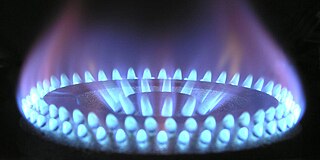Browse, browser or browsing may refer to:

Natural gas is a naturally occurring mixture of gaseous hydrocarbons consisting primarily of methane (97%) in addition to various smaller amounts of other higher alkanes. Low levels of trace gases like carbon dioxide, nitrogen, hydrogen sulfide, and helium are also usually present. Methane is colorless and odorless, and the second largest greenhouse gas contributor to global climate change after carbon dioxide. Because natural gas is odorless, odorizers such as mercaptan are commonly added to it for safety so that leaks can be readily detected.

Liquefied natural gas (LNG) is natural gas (predominantly methane, CH4, with some mixture of ethane, C2H6) that has been cooled down to liquid form for ease and safety of non-pressurized storage or transport. It takes up about 1/600th the volume of natural gas in the gaseous state at standard conditions for temperature and pressure.
Compressed natural gas (CNG) is a fuel gas mainly composed of methane (CH4), compressed to less than 1% of the volume it occupies at standard atmospheric pressure. It is stored and distributed in hard containers at a pressure of 20–25 megapascals (2,900–3,600 psi), usually in cylindrical or spherical shapes.

A Natural Gas Vehicle (NGV) is an alternative fuel vehicle that uses compressed natural gas (CNG) or liquefied natural gas (LNG). Natural gas vehicles should not be confused with autogas vehicles powered by liquefied petroleum gas (LPG), mainly propane, a fuel with a fundamentally different composition.

Sempra is a North American public utility holding company based in San Diego, California. The company is one of the largest utility holding companies in the United States with nearly 40 million consumers. Sempra's focus is on electric and natural gas infrastructure and its operating companies include: Southern California Gas Company (SoCalGas) and San Diego Gas & Electric (SDG&E) in Southern California; Oncor Electric Delivery Company in Texas; and Sempra Infrastructure, with offices in California and Texas.
Gasum Oy is a Finnish state-owned energy company operating in the Nordics. Gasum owns 17 biogas refineries in Finland and Sweden, and is the largest processor of biodegradable waste in the Nordic countries. In addition, Gasum sells wind power and provides various energy market services. It is in the process of building a gas filling station network that will also serve heavy-duty vehicles.
The Maritimes and Northeast Pipeline is a natural gas transmission pipeline that runs from the Sable Offshore Energy Project (SOEP) gas plant in Goldboro, Nova Scotia, Canada to Dracut, Massachusetts, United States.
The energy policy of India is to increase the locally produced energy in India and reduce energy poverty, with more focus on developing alternative sources of energy, particularly nuclear, solar and wind energy. Net energy import dependency was 40.9% in 2021-22.
FortisBC is a Canadian owned, British Columbia based regulated utility providing natural gas, and electricity. FortisBC has approximately 2,600 employees serving more than 1.2 million customers in 135 B.C. communities and 58 First Nations communities across 150 Traditional Territories.

GAIL (India) Limited is an Indian state-owned energy corporation with primary interests in the trade, transmission and production distribution of natural gas. GAIL also has interests in the exploration and production solar and wind power, telecom and telemetry services (GAILTEL) and electricity generation. GAIL was founded as the Gas Authority of India Ltd. in August 1984 under the Ministry of Petroleum and Natural Gas to build, operate and maintain the HVJ Gas Pipeline. On 1 February 2013, the Indian government conferred GAIL with Maharatna status along with 11 other Public Sector Undertakings (PSUs).

An LNG carrier is a tank ship designed for transporting liquefied natural gas (LNG).

Snam S.p.A. is an Italian energy infrastructure company.

The Japan Crude Cocktail (JCC) is the informal nickname given to the pricing index of Crude Oil used in most East Asian countries. The JCC is the average price of customs-cleared crude oil imports into Japan and is published by the Petroleum Association of Japan. The official name of the JCC is the Japan Customs-cleared Crude Oil Price. The valuation of the JCC closely reflects the market state of supply and demand. Clear fluctuations in JCC pricing can be linked to distinct events such as the 2007-08 Global Financial Crisis and the 2011 Fukushima Disaster.
Natural gas was Canada's third largest source of energy production in 2018, representing 22.3% of all energy produced from fuels in the country. By contrast, the share of fuel-based energy production from natural gas in 2013 was 17.0%, indicating a growth rate of approximately 1.06% per year.
The United Kingdom's National Transmission System (NTS) is the network of gas pipelines that supply gas to about forty power stations and large industrial users from natural gas terminals situated on the coast, and to gas distribution companies that supply commercial and domestic users. It covers Great Britain, i.e. England, Wales and Scotland.
The Brunswick Pipeline is a natural gas transmission pipeline in the Canadian province of New Brunswick.
Latvia is a net energy importer. Primary energy use in Latvia was 49 TWh, or 22 TWh per million persons in 2009. In 2018, electricity consumption per capita was 3731 kWh.

A gas carrier, gas tanker, LPG carrier, or LPG tanker is a ship designed to transport LPG, LNG, CNG, or liquefied chemical gases in bulk.

A liquefied natural gas terminal is a facility for managing the import and/or export of liquefied natural gas (LNG). It comprises equipment for loading and unloading of LNG cargo to/from ocean-going tankers, for transfer across the site, liquefaction, re-gasification, processing, storage, pumping, compression, and metering of LNG. LNG as a liquid is the most efficient way to transport natural gas over long distances, usually by sea.









